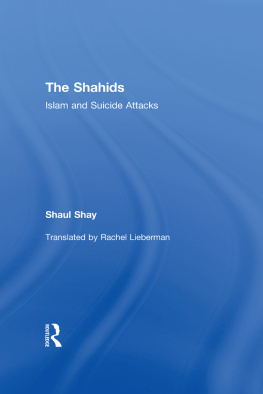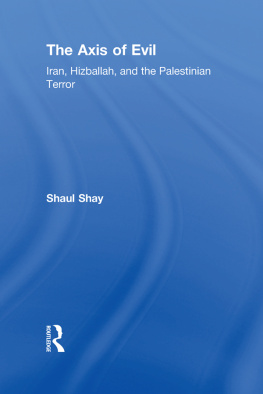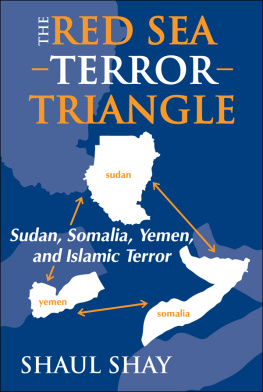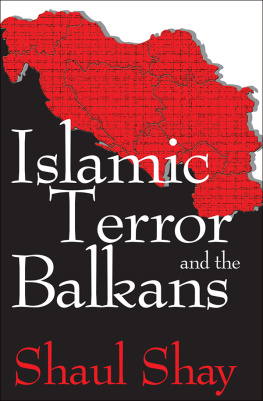The Red Sea
Region
between War and
Reconciliation
The Red Sea
Region
between War and
Reconciliation
SHAUL SHAY
Copyright Shaul Shay, 2019.
Published in the Sussex Academic e-Library, 2019.
SUSSEX ACADEMIC PRESS
PO Box 139, Eastbourne BN24 9BP, UK
Ebook editions distributed worldwide by
Independent Publishers Group (IPG)
814 N. Franklin Street
Chicago, IL 60610, USA
ISBN 9781782846666 (Epub)
ISBN 9781782846666 (Kindle)
ISBN 9781782846666 (Pdf)
All rights reserved. Except for the quotation of short passages for the purposes of criticism and review, no part of this publication may be reproduced, stored in a retrieval system, or transmitted, in any form or by any means, electronic, mechanical, photocopying, recording or otherwise, without the prior permission of the publisher.
British Library Cataloguing in Publication Data
A CIP catalogue record for this book is available from the British Library.
This e-book text has been prepared for electronic viewing. Some features, including tables and figures, might not display as in the print version, due to electronic conversion limitations and/or copyright strictures.
Dedication to come
Contents
List of Acronyms and Abbreviations
Arab and African Coastal States of the Red Sea and the Gulf of Aden (AARSGA)
African Union (AU)
Al-Qaeda of Arab Peninsula (AQAP)
China Merchants Group (CMG).
Comprehensive Operation Sinai 2018 (CO2018)
Cooperative Framework Agreement (CFA)
Doraleh Container Terminal (DCT)
Egyptian Nuclear and Radiological Regulatory Authority (ENRRA)
Ethiopia and the International Atomic Energy Agency (IAEA)
EthiopiaEritrea Boundary Commission (EEBC)
European Union (EU)
French forces in Djibouti (FFDJ)
Grand Renaissance Dam (GERD)
Gulf Cooperation Councils (GCC)
High-temperature gas-cooled (HTGR)
Intergovernmental Authority on Development (IGAD)
International Atomic Energy Agency (IAEA)
Islamic State (IS)
Joint Comprehensive Plan of Action (JCPOA)
Jordan Atomic Energy Commission (JAEC)
Jordan Nuclear Regulatory Commission (JNRC)
Maritime Self-Defense Force (Maritime SDF)
Middle East Strategic Alliance (MESA)
Nile Basin Initiative (NBI)
Non-Proliferation of Nuclear Weapons (NPT)
Russian State Corporation for Atomic Energy (Rosatom)
Shared Vision Program (SVP)
Support of Trade Exchanges (INSTEX)
The National Dialogue Conference (NDC)
The Suez Canal Economic zone (SCZone)
United Arab Emirates (UAE)

Introduction
The Red Sea Region between War and Reconciliation
The Red Sea is one of the worlds most important trade routes, with its southern tip in Bab el-Mandeb Strait (between Yemen and Djibouti) and its northern edge in the Suez Canal and the Gulf of Aqaba. More than 10 percent of global shipping traffic passes through it every month, including 4 percent of the worlds daily crude oil supply. The global economy depends on the free and undisturbed flow of goods and energy resources and any disruption to shipping on this route would have a profound negative impact on world economy.
The Red Sea and the Gulf of Aden region is composed of nine countries along the coastlines: Somalia, Djibouti, Eritrea, Sudan, Egypt, Israel, Jordan, Saudi Arabia, and Yemen. But, in its wider geopolitical context, the term also includes Ethiopia. This country of 100 million people, although is landlocked country and does not have any Red Sea coastline, is one of the regions most important players and needs to be included in the region in order to provide meaningful analysis.
As a major transit waterway for world trade, the Red Sea has long caught the attention of great powers. It is also a core part of Chinas Belt and Road initiative, which aims to establish land and sea routes linking China to Europe via Eurasia and the Middle East, equivalent of the lucrative Silk Road. The regions unique mixture of historical colonial-power competition, political rivalries, state fragility and emerging circumstances make the Red Sea region one of the worlds most unstable theaters. Over the past years, the Red Sea region has seen dramatic military, economic and political developments that continue to change the geostrategic landscape of the region.
The region has experienced considerable challenges: civil wars (Sudan, South Sudan, Somalia and Yemen); support for armed proxies (Iran supporting the Houthis in Yemen); mass displacements (in Somalia, Sudan and Yemen); and humanitarian crises due both to conflict and to poor governance (in Yemen, Somalia and Sudan). The Red Sea region and the Horn of Africa host more UN peacekeeping missions than any other region in the world.
The Red Sea has become an arena of geopolitical, rivalry and competition on one hand and offers opportunities for development and coordination on the other hand. Expanding economic and strategic interests of global and regional powers, and new economic and military investments, are driving the dynamics of the region. The geostrategic shifts challenge old political structures and bygone economic and social boundaries in the region.
Competition between powers
The Red Sea region is a theater of competition and struggle for influence by the Great Powers: US, China and Russia. China has decided to establish its first military base outside of its borders in Djibouti, a country that hosts the largest US base in Africa, and where France, Japan and Saudi Arabia also have military bases. The US has been a vocal critic of Chinas incursions in the region, especially in Djibouti, long perceived as an American zone of influence.
In recent years, the US has gradually come to perceive the rise of China and Russia as the main threat it is facing in Africa and elsewhere. The US government is putting more effort on the economic front as a positive alternative to China. While the United States realises that it cannot match the scale of Chinese investment in Africa, it is still looking to curb Chinese economic influence in the region. Part of its strategy is to encourage US companies to invest more in East Africa as a positive alternative, and to make clear that engaging with the United States will mean greater prosperity and security for Africa.
Regional competition between Iran and Saudi Arabia
Between September 2014 and March 2015, the Iranian-backed Shiite Houthi rebels took control of a number of areas inside Yemen, including its capital Sanaa, the port city of Aden and the Bab el-Mandeb Strait. Iran, through its Houthi allies, has tried to take control of Bab el-Mandeb, while at the same time wielding political and economic influence in Eritrea and Sudan countries situated on the western shores of the Red Sea where Iran also maintained a military presence.
In March 2015, Saudi Arabia announced it had formed a coalition of ten (mostly Sunni Arab) states in a campaign against the Houthis aimed at restoring power to the government of Yemens President Abed Rabbo Mansour Hadi. The civil war in Yemen has since become an important arena in Iran and Saudi Arabias struggle for regional hegemony. Although the Saudi-led coalition has succeeded in taking control of the area around Bab el-Mandeb, as well as the important port of Aden, the military campaign is far from over as the Houthis continue to threaten the waterways with anti-ship missiles, explosives-laden suicide boats and naval mines.














